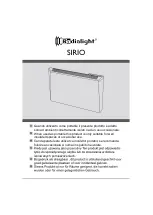
IM 1137-4 • TEMPLIFIER
®
MODEL TGZ
6
www.DaikinApplied.com
I
nsTallaTIon
I
nsTallaTIon
Inspection
When the equipment is received, all items should be carefully
checked against the bill of lading to provide a complete
shipment. All units must be carefully inspected for damage
upon arrival. All shipping damage must be reported to the
carrier and a claim must be filed with the carrier. The unit serial
number plate should be checked before unloading the unit to
be sure that it agrees with the power supply available. Physical
damage to unit after acceptance is not the responsibility of
Daikin Applied.
NOTE:
Unit shipping and operating weights are given in the
Physical Data Tables beginning on
page 25
Handling
Every model TGZ water heater is shipped with a full refrigerant
charge that is isolated in the condenser by the manual
condenser liquid valve and the compressor discharge service
valve.
If the unit has been damaged, allowing the refrigerant to
escape, there can be danger of suffocation in the equipment
area since the refrigerant will displace the air. Be sure to
review Environmental Protection Agency (EPA) requirements
if damage has occurred. Avoid exposing an open flame to the
refrigerant.
The skid option is strongly recommended for ease of handling
and to help prevent damage during installation.
WARNING
Avoid contact with sharp edges. Personal injury can result.
Improper riggin, lifting, or moving of a unit can result in property
damage, severe personal injury or death. Follow rigging and
moving instructions carefully. Do not stand beneath the unit
while it is lifted or being istalled.
Figure 1: Lifting the Unit
It is recommended that all moving and handling be performed
with skids under the unit when possible and that the skids not
be removed until the unit is in the final location. When moving
the unit, dollies or simple rollers can be used under the skids.
Never put the weight of the unit against the control box.
When moving, only apply pressure to the base on the skids,
and not to the piping or shells. Avoid dropping the unit at the
end of the roll.
If the unit must be hoisted, it is necessary to lift the unit by
attaching cables or chains at the lifting holes located on the
disposable lifting bars. Spreader bars must be used to protect
the control cabinet and other areas of the unit. See
Figure 1.
Do not attach slings to piping or equipment. Move unit in the
upright horizontal position at all times. Set unit down gently
when lowering from the trucks or rollers. See
Table 12 on page
24 for total and point weights.
Location
The unit is designed for indoor application and must have
equipment room temperature for operating and standby
conditions between 40°F to 122°F (4.4°C to 50°C).
Because of the electronic control devices, the units should not
be exposed to the weather. A plastic cover over the control
box is supplied as temporary protection during shipment. A
reasonably level and sufficiently strong floor is required for
the unit. If necessary, additional structural members should
be provided to transfer the weight of the unit to the nearest
beams.
NOTE:
Unit shipping and operating weights are available in
the weights section starting in
Table 12 on page 24
Placing the Unit
The small amount of vibration normally encountered with the
water chiller makes this unit particularly desirable for basement
or ground floor installations where the unit can be mounted
directly to the floor. The floor construction should be such that
the unit will not affect the building structure nor will it transmit
noise and vibration into the structure.
Vibration Isolators
It is recommended that isolators be used on all upper level
installations or in areas where vibration transmission is a
consideration.
Figure 2: Isolator Locations
NOTE:
Representative model for isolator location numbering
only; ordered unit configuration may be different than
shown.







































